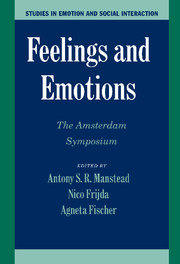Book contents
- Frontmatter
- Contents
- List of Contributors
- 1 Introduction
- PART I THE NATURE OF FEELINGS AND EMOTIONS
- PART II BASIC PSYCHOLOGICAL PROCESSES IN FEELINGS AND EMOTIONS
- PART III FEELINGS AND EMOTIONS: THE PLACE OF PLEASURE
- PART IV FEELINGS AND EMOTIONS IN THEIR SOCIOCULTURAL CONTEXT
- PART V FEELINGS, EMOTIONS, AND MORALITY
- 22 On the Possibility of Animal Empathy
- 23 Emotional Gifts and “You First” Micropolitics
- 24 Introducing Moral Emotions into Models of Rational Choice
- 25 Virtue and Emotional Demeanor
- 26 Epilogue
- Subject Index
- Author Index
- Plate section
- References
22 - On the Possibility of Animal Empathy
Published online by Cambridge University Press: 05 June 2012
- Frontmatter
- Contents
- List of Contributors
- 1 Introduction
- PART I THE NATURE OF FEELINGS AND EMOTIONS
- PART II BASIC PSYCHOLOGICAL PROCESSES IN FEELINGS AND EMOTIONS
- PART III FEELINGS AND EMOTIONS: THE PLACE OF PLEASURE
- PART IV FEELINGS AND EMOTIONS IN THEIR SOCIOCULTURAL CONTEXT
- PART V FEELINGS, EMOTIONS, AND MORALITY
- 22 On the Possibility of Animal Empathy
- 23 Emotional Gifts and “You First” Micropolitics
- 24 Introducing Moral Emotions into Models of Rational Choice
- 25 Virtue and Emotional Demeanor
- 26 Epilogue
- Subject Index
- Author Index
- Plate section
- References
Summary
ABSTRACT
Animal empathy has received little attention. In monkeys and apes, however, it is not unusual for one individual to respond emotionally to the distress of others. These responses have been measured in observational research and tested experimentally, allowing the conclusion that emotional resonance and targeted helping are within the capacity of other animals.
THE EVOLUTION OF EMOTIONAL LINKAGE
When Carolyn Zahn-Waxler visited homes to find out how children responded to family members who were instructed to feign sadness (sobbing), pain (crying), or distress (choking), she discovered that children a little over one year of age already comfort others. Since expressions of sympathy emerge at an early age in virtually every member of our species, they are as natural as the first step. An unplanned sidebar to this study, however, was that some household pets appeared to be as worried as the children by the “distress” of a family member, hovering over them or putting their heads in their laps (Zahn-Waxler et al., 1984).
The possibility that animals possess empathy and sympathy has received scant systematic attention due to two factors. One is fear of anthropomorphism, which has created unnecessary taboos surrounding animal emotions (de Waal, 1999). The other hampering influence has been Huxley's (1894) dualism between nature and ethics, which still dominates the thinking of some contemporary biologists. This “nature red in tooth and claw” view has little room for kindness, human or animal.
- Type
- Chapter
- Information
- Feelings and EmotionsThe Amsterdam Symposium, pp. 381 - 401Publisher: Cambridge University PressPrint publication year: 2004
References
- 13
- Cited by

